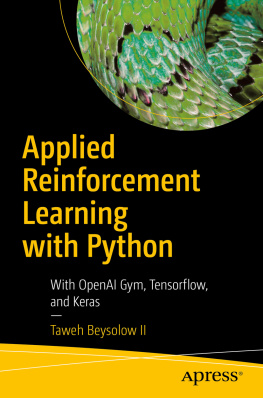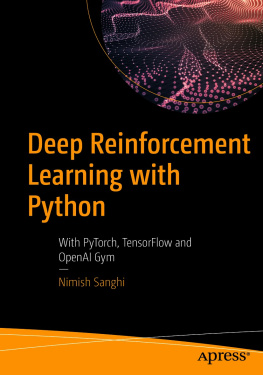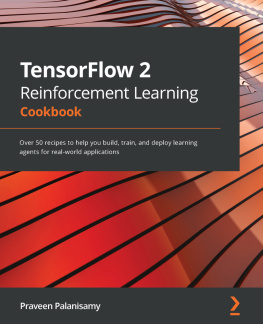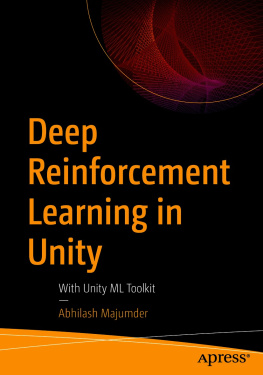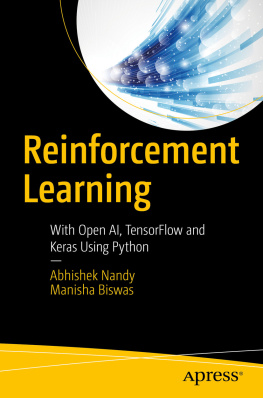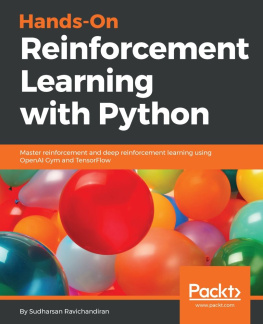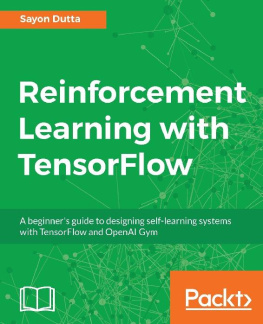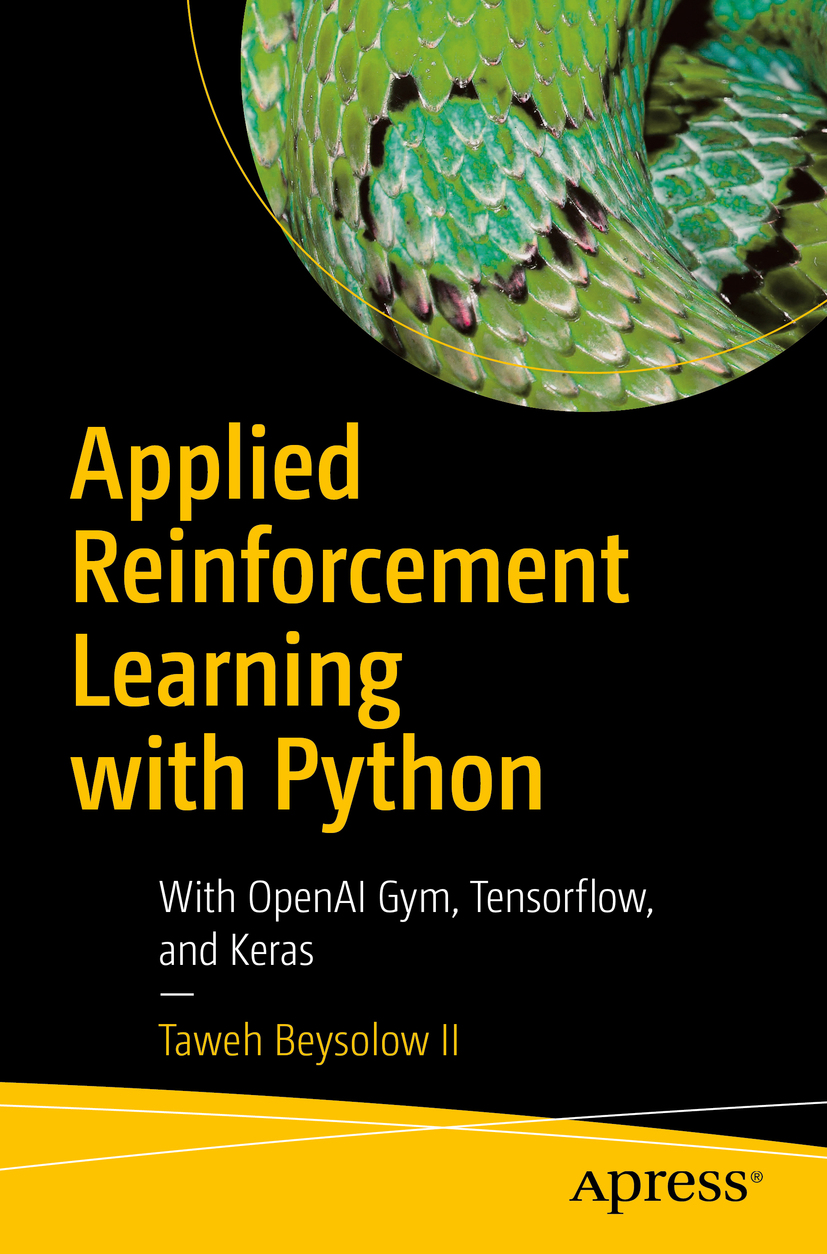Taweh Beysolow II
Applied Reinforcement Learning with Python
With OpenAI Gym, Tensorflow, and Keras
Taweh Beysolow II
San Francisco, CA, USA
Any source code or other supplementary material referenced by the author in this book is available to readers on GitHub via the books product page, located at www.apress.com/978-1-4842-5126-3 . For more detailed information, please visit http://www.apress.com/source-code .
ISBN 978-1-4842-5126-3 e-ISBN 978-1-4842-5127-0
https://doi.org/10.1007/978-1-4842-5127-0
Taweh Beysolow II 2019
Apress Standard
Trademarked names, logos, and images may appear in this book. Rather than use a trademark symbol with every occurrence of a trademarked name, logo, or image we use the names, logos, and images only in an editorial fashion and to the benefit of the trademark owner, with no intention of infringement of the trademark. The use in this publication of trade names, trademarks, service marks, and similar terms, even if they are not identified as such, is not to be taken as an expression of opinion as to whether or not they are subject to proprietary rights.
While the advice and information in this book are believed to be true and accurate at the date of publication, neither the authors nor the editors nor the publisher can accept any legal responsibility for any errors or omissions that may be made. The publisher makes no warranty, express or implied, with respect to the material contained herein.
Distributed to the book trade worldwide by Springer Science+Business Media New York, 233 Spring Street, 6th Floor, New York, NY 10013. Phone 1-800-SPRINGER, fax (201) 348-4505, e-mail orders-ny@springer-sbm.com, or visit www.springeronline.com. Apress Media, LLC is a California LLC and the sole member (owner) is Springer Science + Business Media Finance Inc (SSBM Finance Inc). SSBM Finance Inc is a Delaware corporation.
This book is dedicated to my friends and family who supported me through the most difficult of times for the past decade. They have enabled me to be the person I am capable of being when operating at my best. Without you, I would not have the ability to continue living as happily as I am.
Introduction
It is a pleasure to return for a third title with Apress! This text will be the most complex of those I have written, but will be a worthwhile addition to every data scientist and engineers library. The field of reinforcement learning has undergone significant change in the past couple of years, and it is worthwhile for everyone excited with artificial intelligence to engross themselves in.
As the frontier of artificial intelligence research, this will be an excellent starting point to familiarize yourself with the status of the field as well as the most commonly used techniques. From this point, it is my hope that you will feel empowered to continue on your own research and innovate in your own respective fields.
Acknowledgments
I would like to thank Santanu, Divya, Celestin, and Rita. Without you, this book would not be nearly as much of a success as it will be. Secondarily, I would like to thank my family and friends for their continued encouragement and support. Life would not be worth living without them.
Table of Contents
About the Author and About the Technical Reviewer
About the Author
Taweh Beysolow II
is a data scientist and author currently based in the United States. He has a bachelor of science in economics from St. Johns University and a master of science in applied statistics from Fordham University. After successfully exiting the start-up he co-founded, he now is a Director at Industry Capital, a San Franciscobased private equity firm, where he helps lead the cryptocurrency and blockchain platforms.
About the Technical Reviewer
Santanu Pattanayak
currently works at GE Digital as a Staff Data Scientist and is author of the deep learning book Pro Deep Learning with TensorFlow (Apress, 2017). He has 8 years of experience in the data analytics/data science field and also has a background in development and database technologies. Prior to joining GE, Santanu worked in companies such as RBS, Capgemini, and IBM. He graduated with a degree in electrical engineering from Jadavpur University, Kolkata, and is an avid math enthusiast. Santanu is currently pursuing a masters degree in data science from the Indian Institute of Technology (IIT), Hyderabad. He also devotes his time to data science hackathons and Kaggle competitions where he ranks within the top 500 across the globe. Santanu was born and brought up in West Bengal, India, and currently resides in Bangalore, India, with his wife.
Taweh Beysolow II 2019
T. Beysolow II Applied Reinforcement Learning with Python https://doi.org/10.1007/978-1-4842-5127-0_1
1. Introduction to Reinforcement Learning
Taweh Beysolow II
(1)
San Francisco, CA, USA
To those returning from my previous books, Introduction to Deep Learning Using R it is a pleasure to have you as readers again. To those who are new, welcome! Over the past year, there have continued to be an increased proliferation and development of Deep Learning packages and techniques that revolutionize various industries. One of the most exciting portions of this field, without a doubt, is Reinforcement Learning (RL). This itself is often what underlies a lot of generalized AI applications, such as software that learns to play video games or play chess. The benefit to reinforcement learning is that the agent can familiarize itself with a large range of tasks assuming that the problems can be modeled to a framework containing actions, an environment, an agent(s). Assuming that, the range of problems can be from solving simple games, to more complex 3D games, to teaching self-driving cars how to pick up and drop off passengers in a variety of different places as well as teaching a robotic arm how to grasp objects and place them on top of a kitchen counter.
The implications of well-trained and deployed RL algorithms are huge, as they more specifically seek to drive artificial intelligence outside of some of the narrow AI applications spoken about in prior texts I have written. No longer is an algorithm simply predicting a target or label, but instead is manipulating an agent in an environment, and that agent has a set of actions it can choose to achieve a goal/reward. Examples of firms and organizations which devote much time to researching Reinforcement Learning are Deep Mind as well as OpenAI , whose breakthroughs in the field are among the leading solutions. However, let us give a brief overview of the history of the field itself.

